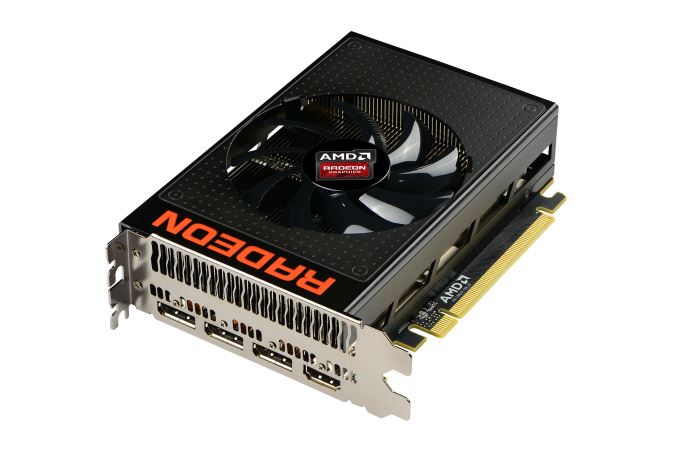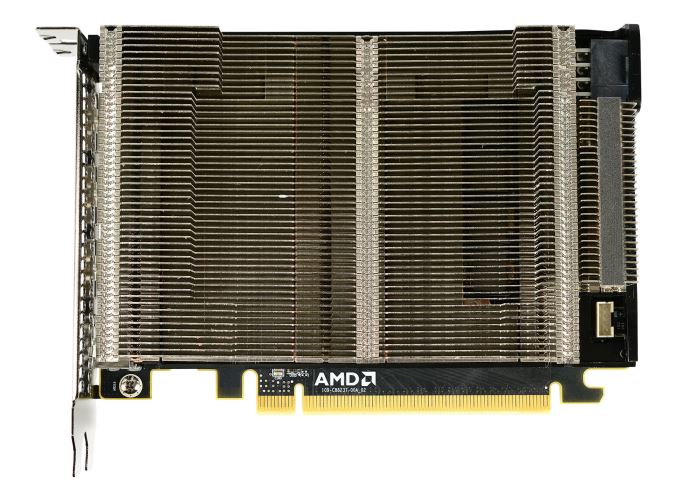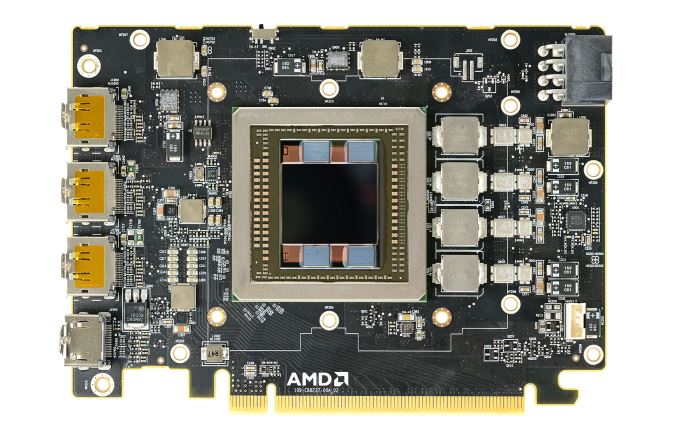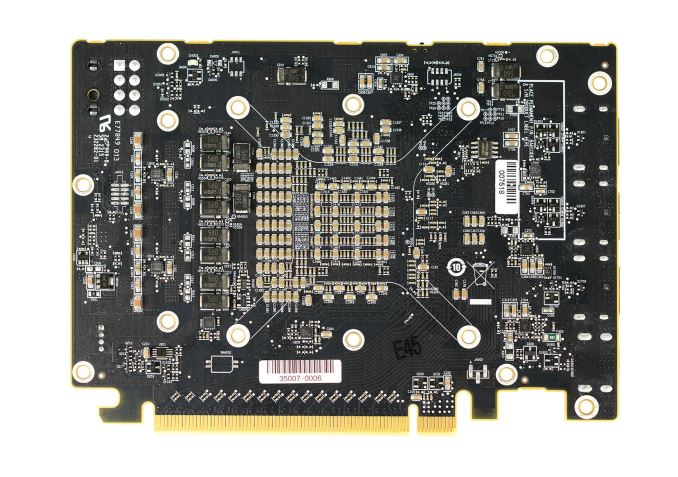The AMD Radeon R9 Nano Review: The Power of Size
by Ryan Smith on September 10, 2015 8:00 AM ESTMeet The Radeon R9 Nano
6 inch video cards are by no means a new thing in the GPU space, however these are traditionally lower-end products that need neither a large cooler nor an extensive power delivery system. As a result the R9 Nano is something of an interesting aberration, packing a lot more power and a lot more technology into half a foot of video card than what we normally see.
Starting as always from the top, the R9 Nano measures 6” long, which is actually a bit shorter than the full length the Mini-ITX standard allows. Responsibility for cooling the card falls to the R9 Nano’s new open air cooler, an aggressive design that has been specifically tailored to allow the card to effectively dissipate 175W of heat in such a small space.
The overall design of the R9 Nano’s cooler is best described as a combination open-air and half-blower hybrid. The design is technically open-air, employing a single axial fan to cool the card. However with only a single fan AMD has been able to align the heatsink fins horizontally and then place the fan in the center of the heatsink. The end result is that roughly half of the heat produced by the card is vented outside of the case, similar to a full blower, while the other half of the heat is vented back into the case. This reduces (though doesn’t eliminate) the amount of hot air being recycled by the card.
The heatsink itself is composed of aluminum and runs virtually the entire length of the card. This is technical a two-piece heatsink, with the primary heatsink composing the bulk of the card, while a much smaller secondary heatsink it found towards the far end of the card and mounted on top of a heatpipe.
Drilling down, we find that the primary heatsink is fed by a combination vapor chamber and heatpipe design. A copper vapor chamber serves to draw heat away from the Fiji GPU and HBM stacks, and then heatpipes are used to better distribute heat to the rest of the heatsink. The use of a vapor chamber in the R9 Nano makes a lot of sense given the fact that vapor chambers are traditionally the most efficient heatsink base type, however the R9 Nano is also unique in that we typically don’t see vapor chambers and heatpipes used together. Other designs such as the high-end GeForce series use a single large vapor chamber across the entire heatsink base, so among reference cards at least the R9 Nano stands alone in this respect. In this case given AMD’s design goals for size and noise, a vapor chamber will play a big part in helping the small card effectively and quietly dissipate 175W.
As for the physical PCB itself, as we can see AMD made it a relatively packed card in order to get the R9 Nano down to 6 inches. Compared to the R9 Fury X reference board, the biggest change here is that AMD has removed a fair bit of power circuitry to save space. By our count there are 4 VRM phases to feed the Fiji GPU, as opposed to the 6 found on R9 Fury X. Power delivery is handled by a single 8-pin PCIe power socket, which is becoming increasingly common, replacing the 2x 6-pin setup for 150W-225W cards.
Meanwhile to further shrink the overall PCB footprint, AMD has moved some of the remaining power delivery circuitry to the back of the card. The front of the card still contains the inductors and heat-sensitive MOSFETs, while a number of capacitors are on the rear of the card (and is why you won’t find a backplate).
Finally, for display I/O R9 Nano is unchanged from R9 Fury X. This means we’re looking at a DVI-free design, with 3x DisplayPort 1.2 and 1x HDMI 1.4 port all along a single row of the I/O bracket. Buyers looking to put together HTPCs will want to be especially mindful of the HDMI 1.4 port; while it's not necessarily a deal-breaker, it does mean that the R9 Nano can't fully drive 4Kp60 TVs, which are slowly but surely becoming more common.
Overall AMD is rather confident in their design for the R9 Nano. The heatsink is built to efficiently dissipate more heat than the 175W the card requires (despite the small size), and as a result we never see the R9 Nano thermally throttle under normal operation. The card’s thermal throttle point is 85C, and in our testing the card never passed 75C, exactly as AMD promised us. What ends up limiting the R9 Nano’s performance then is exactly as expected: the power throttling.
















284 Comments
View All Comments
Drumsticks - Thursday, September 10, 2015 - link
??? I never said I was going to buy the Nano. You just said exactly what my plan was, to buy a GPU when 16nm FF hits. I'm still chugging along with 1080p and a 7850, but I'll probably be grabbing QuadHD or 4K next year with a big GPU upgrade.That doesn't mean that looking at potential DX12 performance now won't give a hint of what's to come, though. AMD stands to gain a lot from dx12 from what we've seen.
mosu - Thursday, September 10, 2015 - link
With a 16nm FinFet you'll get Nvidia, a 14nm FinFET will come from Glo-Foundries, so you'll get something from AMD.extide - Thursday, September 10, 2015 - link
It's NOT a lack of ROP's guys, its a lack of geometry bhardware. Check out the pixel fill rate tests, that does NOT indicate a lack of ROP's. This car beats the 980 at high res, but not low res, thats NOT a ROP issue, that's either driver overheard and/or geometry issue.silverblue - Friday, September 11, 2015 - link
I wonder if AMD has ever responded to the issue of driver overhead. If not, they should. It's a massacre at lower resolutions and detail levels at times.jardows2 - Thursday, September 10, 2015 - link
I do not see any enthusiast buying this card for their own build. Where I do see this card selling is in boutique systems sold for a combination of style and performance. In a tiny system targeted for 1440 gaming, which I think should be the focus rather than 4k, this would do great!MrSpadge - Thursday, September 10, 2015 - link
That voltage-frequency curve looks horrible! From the average clocks speeds we know the card is mostly running between 800 and 900 MHz. Yet on that plot we see no power states defined between 0.93 V and 1.04 V. Yet that's where the card would need to operate between 750 and 850 MHz. Why is AMD limiting their power efficiency by providing too few power states? Or is it simply a matter of measuring the low voltages correctly?teiresias - Thursday, September 10, 2015 - link
What were the terms Anandtech agreed to with Roy Taylor in order to secure this Nano sample? I honestly can't take any review of this product seriously unless the editorials of each site come out with statements on what their agreements with AMD were concerning review content.Ryan Smith - Thursday, September 10, 2015 - link
"What were the terms Anandtech agreed to with Roy Taylor in order to secure this Nano sample?"For the record I didn't need to agree to any terms. Nor have I conversed with Roy in quite some time.
jtrdfw - Thursday, September 10, 2015 - link
Thats good.Wreckage - Thursday, September 10, 2015 - link
If they agreed to anything it would probably be covered under a "non disclosure agreement" so legally they would not be able to say anything. Such an agreement would come from AMD marketing, not from Roy directly. I assume there was some sort of reviewers guide they wanted people to follow. How strictly any site followed that guide or why certain sites were deemed "fair" by AMD will most likely remain speculation